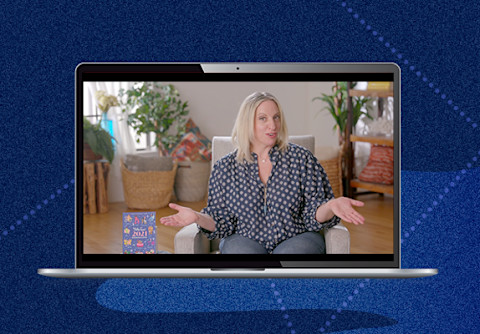Lunar & Solar Eclipses 101: Everything You Need To Know About These Rare Events

Eclipses aren't always visible to everyone on the planet, but trust—even if you can't see an eclipse happening, you're still going to feel the effects of this important cosmic event. Here's what you need to know about what causes lunar and solar eclipses and what they mean for you.
What are lunar and solar eclipses?
There are two major types of eclipses: lunar eclipses and solar eclipses. Lunar eclipses involve the moon, and solar eclipses involve the sun. Eclipses are more rare than new moons and full moons: They happen four to six times annually.
A total lunar eclipse occurs when the Earth is directly between the sun and a full moon. The shadow from the earth will temporarily give the moon a red, brown, or gray hue. There are two other types of lunar eclipses: partial and penumbral. A partial lunar eclipse happens when the Earth is not directly in line with the sun and moon, causing only part of the moon to be cast in the Earth's shadow. A penumbral lunar eclipse happens when the sun, Earth, and moon are this close to being perfectly aligned, but aren't quite there, making it difficult to tell these eclipses apart from a regular full moon.
A solar eclipse, on the other hand, happens when a new moon sits directly between the sun and Earth. If this happens during the daytime in an area where the eclipse is visible, you can see the moon fully blot out the sun for a few moments.
While the image of a total solar eclipse (cue Bonnie Tyler) is probably the one you're most familiar with, there are two other types of solar eclipses: partial and annular. A partial solar eclipse is when the sun, moon, and Earth don't perfectly align, so only part of the sun is blocked by the moon. An annular solar eclipse, also called a "ring of fire" (paging Johnny Cash?) happens when the moon doesn't fully block the sun, leaving a flaming outline around it.
You're much more likely to get a good view of a lunar eclipse since solar eclipses are usually only visible from a certain path on Earth. Pro tip: Total lunar eclipses—often called "blood moons" because of the reddish tinge the moon takes on—are the real showstoppers for sky gazers. At these events, the moon sits in the Earth's shadow, and the only light cast on it comes from the outer edges of our planet, where sunrises and sunsets are happening. This is what creates the buzzed-about "blood moon" look.
What's the spiritual meaning and significance of eclipses?
In ancient times, eclipses were feared by many civilizations. Some believed that eclipses defied the laws of nature and even had an apocalyptic quality! Today, we know that eclipses are a normal occurrence—but they still carry an intense energy.
In astrology, the sun represents our conscious mind and our creative power, and the moon represents our emotions and our unconscious. If you think about the symbolism of the moon blocking out the sun, you can get a pretty good read on the energy of a solar eclipse. Heightened feelings can "eclipse" our so-called rational judgment, driving up intense reactions.
Solar eclipses are a time to reflect internally, to embrace new opportunities that are coming your way, and deal with the past themes from your life. They can bring bold beginnings out of the blue, or a surge of motivation to start a new path that's better suited to your soul. You can think of the energy stirred by a solar eclipse like an introspective new moon hyped up on 10 matcha lattes.
A lunar eclipse heightens the energy of the full moon and is a time to embrace endings and let go of things that are no longer serving you—ready or not. This may happen abruptly at these supercharged full moons—a situation or person can literally be "eclipsed" out of your life. While it can be jarring, this intense illumination allows us to see people (and ourselves) in a new light—and forces us to deal with our shadows. A lunar eclipse helps you realize who you want to be and identify your next areas for growth.
Eclipses are the cosmic cleanup crew and catalysts, believed to bring on abrupt endings and beginnings. They're the push we need to make change in our lives.
What to do—and what not to do—during eclipses.
DO: Identify your feelings.
Eclipses usher in change—and fast. We may not have time to think, much less process how we feel about these sudden events! Journaling, meditating, or talking things through with a wise adviser can help you make sense of what the cosmos are trying to tell you.
DON'T: Make any sudden decisions.
This may seem counterintuitive. After all, an eclipse's whole deal is "change"—like, yesterday. But emotions are running high, and the energy in the days before and after an eclipse is still a bit chaotic. When possible, avoid making any rash decisions.
DO: Connect with the earth.
Staying grounded can be especially helpful during a lunar eclipse. It could be as simple as taking off your shoes and walking barefoot outside or touching a tree. You could bring a new plant into your home or pick up a crystal associated with the zodiac sign that the eclipse is falling in.
DON'T: Neglect your self-care routines.
Eclipse energy can be exhausting, which can make it harder to stick to your self-care routines. Squeezing in a workout can seem minor compared to dealing with all of the drama an eclipse can dredge up. But this is exactly the time when stress relief (and release) can help the most—even if you just take a power walk or a quick bike ride.



